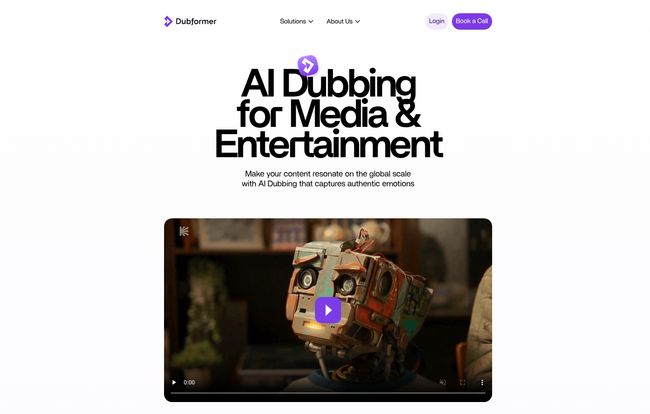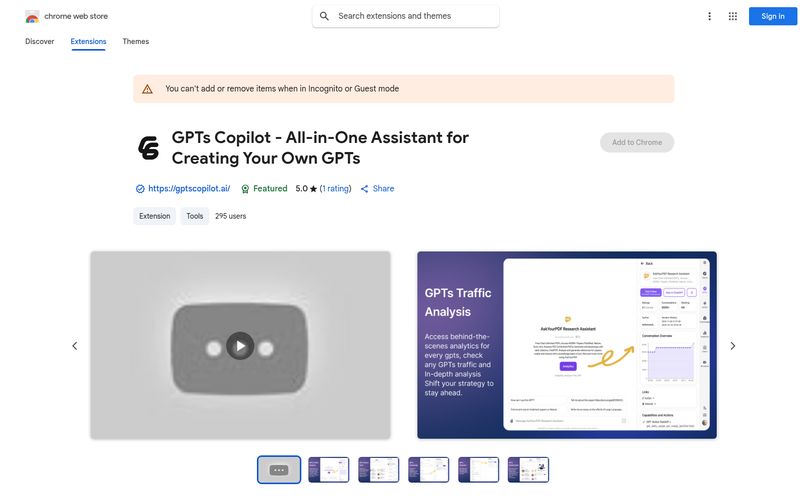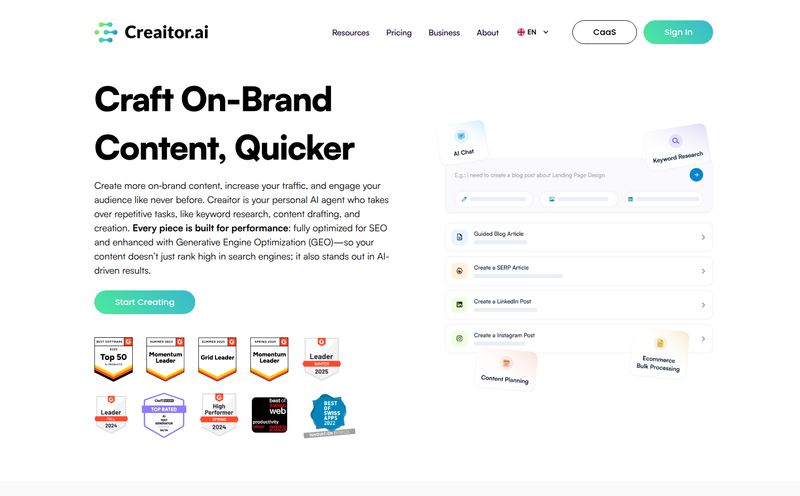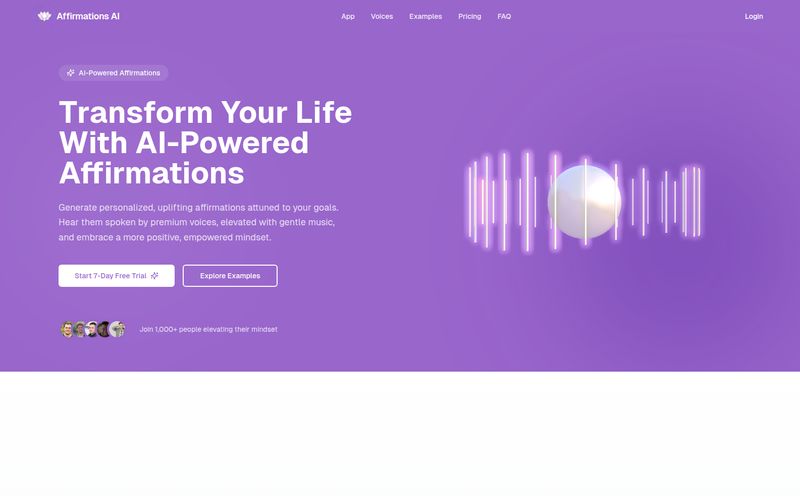I don’t know about you, but I’ve sat through more than my fair share of horribly dubbed foreign films. You know the ones. The audio is flat, the voices sound like they were recorded in a tin can, and the emotion on screen is completely disconnected from the words you're hearing. It’s a surefire way to ruin a perfectly good movie night. For years, the choice has been either to put up with bad dubs, learn a new language, or just stick to subtitles.
But the world of content localization is getting a serious shake-up. AI has entered the chat, and it’s promising to do for voiceovers what it's done for, well, everything else. I’ve been keeping a close eye on this space, and a platform called Dubformer recently caught my attention. It claims to offer AI dubbing that’s not just about translating words, but translating emotions. Big claim. So, naturally, I had to see what was under the hood.

Visit Dubformer
So What Exactly Is Dubformer?
At its core, Dubformer is an AI-powered platform designed for dubbing and voiceovers, specifically targeting the media and entertainment industry. Think content creators, production houses, localization companies, and any business that looks at a world map and sees potential customers instead of borders. The whole pitch is about creating “monetization-ready” dubbing that sounds genuinely human. It’s an ambitious goal, aiming to bridge the gap between expensive, time-consuming traditional dubbing studios and the cheap, but often robotic, text-to-speech tools of the past.
The Seismic Shift from Traditional Studios to AI
Let's be real for a second. Traditional dubbing is an art form, but it's also incredibly expensive and slow. You need to hire voice actors, book studio time, hire directors, sound engineers... the list goes on. It's a massive barrier to entry for anyone who isn’t a major Hollywood studio. This is why you see so much incredible content from around the globe that never reaches an English-speaking audience, and vice-versa.
AI platforms like Dubformer are changing that calculus. They're making it possible for a YouTuber in Seoul, an indie filmmaker in Brazil, or an e-learning company in Germany to reach a global audience without breaking the bank. It's about accessibility. It's about speed. And if they get it right, it's about maintaining the original creator's artistic intent. That’s the dream, anyway.
Dubformer's Most Interesting Features
Okay, let’s get into the good stuff. What does this tool actually do? I poked around their site and documentation, and a few things really stood out.
The Magic of Emotion Transfer Technology
This is the feature that made me sit up and pay attention. Dubformer isn’t just converting text to speech. It claims its AI analyzes the original speaker's tone, rhythm, and emotional inflection and then replicates it in the target language. As their own site puts it, great dubbing is about “emotions, rhythm, and the human touch.” This is the holy grail. Think of it less like a robotic voice-over and more like a vocal chameleon, adapting the performance to fit a new language. If it works as advertised, this alone could be a massive game-changer.
A Universe of Voices and Languages
The scale here is pretty impressive. Dubformer boasts support for over 130 languages and a library of more than 1000 different voices. Plus, it offers voice cloning. This means you could potentially clone an actor's voice and have them “speak” a dozen languages fluently, all while maintaining their unique vocal signature. For brand consistency across international marketing campaigns, that’s huge.
Dubbing for the Livestreaming Era
Here’s something I haven’t seen much elsewhere: live stream dubbing. The platform breaks this down into a multi-step process that happens in near real-time: it identifies different speakers, transcribes what they're saying (speech-to-text), translates it, and then generates a dubbed audio stream using an appropriate AI voice. Imagine watching a live international news broadcast or a global gaming tournament with real-time dubbing. The potential applications are wild.
Seamless Workflow and Integration
For the pros and agencies out there, workflow is everything. Dubformer seems to get this. They offer an API, which means developers can integrate Dubformer's tech directly into their own content management systems or production pipelines. They also tout an “end-to-end dubbing in 3 clicks” process on their self-service platform. I’m always a bit skeptical of “X-clicks” marketing, as there’s usually more to it, but it signals a focus on user-friendliness and efficiency that I appreciate.
The Good, The Bad, and The Realistic
No tool is perfect. As an SEO and traffic guy, I've seen a thousand platforms promise the world. Here's my honest breakdown of where Dubformer likely shines and where you might need to manage your expectations.
| What I'm Loving About Dubformer | A Few Things to Keep in Mind |
|---|---|
| The focus on emotion and intonation is a huge plus. It shows they understand the biggest failing of most AI voice tools. | Even they admit some post-editing for emotional nuances may be required. This isn't a one-and-done magic button just yet. |
| The sheer cost-effectiveness compared to a traditional dubbing studio is undeniable. This opens up global markets for smaller players. | It's a cloud-based platform, so you'll need a stable internet connection to get any work done. No offline editing. |
| Its workflow integration through an API and a self-serve platform makes it versatile for both one-off projects and large-scale operations. | The pricing is not transparent, which can be a hurdle for those wanting to quickly budget a project. |
Let's Talk Money: The Dubformer Pricing Mystery
So, how much does it all cost? Well, that's the million-dollar question. As I was writing this, I clicked on their pricing page and… got a “Page Not Found” error. Whoops. A little slip-up on their end, maybe a site redesign is in progress.
However, based on the information available and industry standards for this kind of B2B service, it’s almost certain that Dubformer operates on a quote-based model. Pricing for professional studios and enterprise clients will likely depend on the volume of content, the number of languages needed, and whether you’re using the self-service platform or require more hands-on support. I'd expect custom packages rather than a simple three-tiered SaaS pricing chart.
Who Should Be Using Dubformer?
This isn't a tool for everyone, but for a few key groups, it could be a godsend.
- Media Companies & Content Creators: Anyone running a YouTube channel, producing indie films, or creating documentaries who wants to tap into international viewership without a Hollywood budget.
- Localization Companies: Agencies can use this to augment their human talent, speed up workflows, and offer more competitive pricing to their clients. It could be a powerful tool in their arsenal.
- E-Learning and Corporate Training: Businesses that need to deploy training modules across a global workforce can do so much more efficiently and consistently with a tool like this.
Frequently Asked Questions about Dubformer
- How many languages does Dubformer support?
- Dubformer supports over 130 languages, making it one of the more comprehensive platforms for global content localization.
- Can Dubformer actually clone my own voice?
- Yes, the platform includes voice cloning technology, which allows you to create a digital replica of a specific voice that can then be used to generate speech in multiple languages.
- Is Dubformer's AI dubbing truly human-like?
- It's among the best I've seen. The emotion transfer technology aims to capture human-like intonation and rhythm. However, for highly nuanced or dramatic performances, some light post-editing by a human might still be beneficial to achieve perfection.
- What makes Dubformer different from a simple text-to-speech tool?
- The main difference is the focus on dubbing, not just voice generation. It analyzes the source audio's emotion, timing, and speaker characteristics to create a translated performance, rather than just reading text in a monotonous voice.
- Do I need to be a sound engineer to use Dubformer?
- No. While it has powerful features for professionals, including an API, it also offers a self-service platform designed to be user-friendly, with a workflow they claim can be done in just a few clicks.
- How does the live stream dubbing feature work?
- It uses a sequence of AI models to perform speaker identification, speech-to-text transcription, machine translation, and finally, voice generation in near real-time to provide a dubbed audio stream for live events.
My Final Thoughts on Dubformer
Look, the world of AI is moving at a dizzying pace, and it’s easy to be cynical. But I'm genuinely optimistic about tools like Dubformer. It’s not about replacing human creativity but augmenting it. It's about breaking down language barriers that have existed for centuries.
The tech isn't perfect—and it probably never will be without a human touch for that final 1% of quality. But it represents a massive leap forward in making content truly global. For any creator or business that has looked longingly at a foreign market, tools like this are turning a distant dream into a tangible strategy. Dubformer is definitely one to watch.



